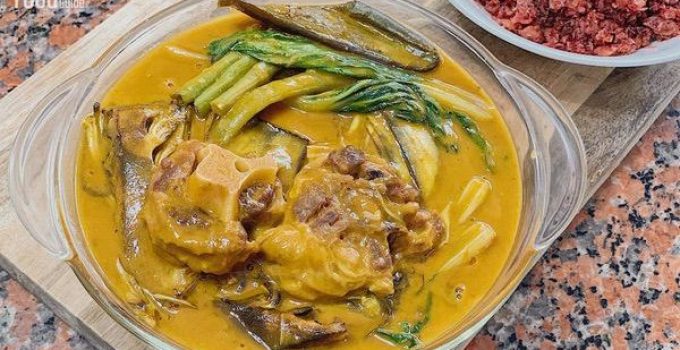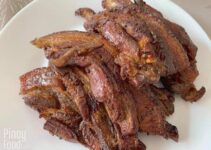Kare Kare is a popular dish here in the Philippines which you might say is one of the all-time favorite dishes of many Filipinos.
Whenever you go to a restaurant which serves mainly Filipino cuisine, it’s almost sure that kare kare is included in the menu, and you’ll almost be tempted to order one. If somehow they don’t serve this irresistible dish, it’s something definitely questionable!
But you don’t need to mind that all–this recipe is sure to brighten your day because you will be able to cook your favorite kare kare in your own home when there’s a special occasion, or even when you just simply want to.
Read on so you can learn how to cook the perfect kare kare recipe we’ve made for you!
What is Kare Kare?
Kare Kare is a classic slow-cooked Filipino stew known for its thick and flavorful yellow peanut sauce paired with a number of vegetables.
It is traditionally based on the use of oxtail or ox tripe, or even the use of both. In this recipe, we will use oxtail as our main meat, but other choices of meat are acceptable nowadays–such as beef, pork, seafood, or even bagnet.
The meat is then simmered for hours depending on how tender you want it to be and is then paired with ground peanuts and ground rice for a thick sauce.
The origin of this meticulous dish is quite ambiguous since some sources say it was invented in Pampanga, since the Kapampangan people always have a knack for cooking and is known for many of the other delicious dishes we enjoy today.
Another source claims that some settlers here who came from Southern India introduced the dish to us, and that the name of the dish came from the word ‘curry‘ which is a type of dish from India. However, the said dish is largely different from kare kare.
Other claims even date back from the pre-Spanish era where kare kare was supposedly invented to be served for the Bangsamoro elite who lived in Manila.
Ingredients You’ll Need
Beef/ Oxtail
Traditionally, oxtail is used as the main meat for kare kare. However, you could also use other tasty parts like ox tripe, pata, maskara or a combination of these.
Peanut butter
Unsalted or less salty peanut butter is preferred. But if you end up using saltier peanut butter, you could skip adding salt while cooking.
Rice Flour
Rice flour or ground rice is traditionally used to thicken the sauce but if this is unavailable you can also use cornstarch or potato starch.
Annatto
Annatto is our main coloring ingredient and it may come in different forms. If you can’t find the powdered form, you can also use seeds or paste.
Vegetables
These are the traditional vegetables that are used in this dish. You could always omit one or two of these in case you can’t find them or if you don’t like them.
Aside from these, we will also be using other regular pantry ingredients like salt, pepper, garlic, onion, fish sauce, and bagoong. If you are filling up your pantry, here’s a handy shopping guide:
Equipment You’ll Need
- Cooking Pot/ Kaldero- For this recipe, you will be needing a deep cooking pot that would be used for boiling the meat and cooking the dish. It could be any size as long as it can fit about 4 cups of water.
- Pressure Cooker- This is an optional cookware but it could greatly shorten your cooking time if you use this.
In need of kitchen tools and equipment? Read this before you buy:
How To Cook Kare Kare?
First thing you’re going to do is to boil the meat. Oxtail in this case. It is important to remember that the meat needs to be tender for the best results.
So ready your oxtail and proceed to clean it by letting it soak a bit on running water and then place it in a deep cooking pot. Pour in a generous amount of water and boil the oxtail in medium heat. Using this method, it will take about 2 hours until the oxtail becomes tender.
You can also test to pierce it with a fork if you’re still unsure about its tenderness. Another method is to use a pressure cooker. This is the better choice since it shortens the cooking time in half. Take note that during this process, you will have to maintain some excess water during boiling which will later serve as a broth.
Next part of the process is to prepare the vegetables for our dish. Here, we are opting to cook the vegetables separately from the meat. Ready up the vegetables you desire to use and prepare a cooking pot with water and boil it.
You can just blanch each of the vegetables separately for about 30 seconds to 1 minute each. You also have the option to saute the vegetables with garlic to add a bit of flavor to it.
Next step is–of course–to prepare the signature peanut sauce. Be very mindful when doing this part of the process since the right amount of combination is needed to achieve the best kare kare.
What we are going to do here is to prepare the annatto powder mixture, this one is responsible for making the sauce a bit reddish.
Then we need to prepare the peanut butter mixture–for this one–you can also add crushed peanuts for an even thicker consistency. And lastly, the rice flour mixture. These mixtures are all achieved by combining them with the broth you made earlier.
Lastly, we are going to bring all of these together. Prepare a large cooking pot by pouring oil into it and set it to low medium heat. Add the oxtail, and cook it until a light brown color is achieved. And then the rice flour mixture, the annatto powder mixture, and the peanut butter mixture.
Proceed to stir until it’s well-combined and continue to cook until the sauce is thick enough. After that, also add in the vegetables. Be sure to add the necessary seasonings in between adding the main ingredients while cooking to achieve the best taste possible.
After all that, what’s left to do is serve it alongside the essential shrimp paste or bagoong. Your kare kare is served!
Cooking Tips
- In case slow cooking isn’t convenient for you, you could always boil the oxtail in a pressure cooker. This will only take about 45 minutes to 1 hour instead of 2 hours.
- Cut meat and vegetables in almost the same sizes so the would cook evenly.
Here are more cooking tips for you: 8 Cooking Secrets You Should Know
How to Serve Kare Kare
Kare kare is a hefty dish that already contains meat and vegetables. You can simple served this with freshly cooked white rice and you’re good to go. This dish is usually served with bagoong alamang, a fermented shrimp condiment that adds a savory flavor to the kare kare. You may mix a small amount of bagoong according to taste.
How to Store and Reheat Kare Kare
In case you have leftovers, store your kare kare in a clean covered food container. Place in a refrigerator and this could prolong its shelf life for up to 3 days.
To reheat, you can either use a microwave oven or place in a cooking pan and heat over low fire until warm.
Other Beef Recipes
For a quick reference about this recipe, see the recipe table below:
Kare Kare Recipe
Equipment
- Cooking Pot
- Pressure Cooker optional
Ingredients
- 1 kg oxtail, cut into serving sizes
- 1 pc banana heart (puso ng saging), cut and pre-soaked for 20 minutes
- 2 pcs large-sized eggplant (talong), halved and cut into serving sizes
- 1 bundle string beans (sitaw), cut into 3 inch sizes
- 1 bundle pechay or bok choy
- 5 cloves garlic
- 1 pc medium-sized onion
- 1/4 cup rice flour or ground rice
- 1 1/2 tbsp annatto powder
- 1 cup peanut butter
- 2 tbsp fish sauce (patis)
- 1 tbsp cooking oil
- salt and pepper, to taste
- bagoong alamang (shrimp paste), served at the side
- water, for boiling
Instructions
- First, let’s prepare the oxtail, clean under running water and place in a deep cooking pot.
- Cover with enough water and apply medium heat then bring to a boil. Remove the scum that rises.
- Lower the heat and add more water. Make sure to maintain about 6 cups of water as we will use the broth later.
- Cover and simmer for about 2 hours or until the oxtails can be pierced by a fork. (See cooking tips above for a quicker cooking time)
- Drain the oxtail and reserve 6 cups of the broth then set aside.
- Next, we prepare the vegetables. In a cooking pot, bring about 4 cups of water to a boil.
- Blanch the banana heart for 1 minute then remove and set aside.
- Blanch the eggplant for 1 minute then remove and set aside.
- Blanch the string beans for 1 minute then remove and set aside.
- Blanch the pechay/ bok choy for 30 seconds then remove and set aside.
- Place the rice flour in a skillet or frying pan and apply medium heat.
- Cook the rice flour, while stirring occasionally, until lightly browned and toasted.
- Combine the toasted rice flour and 1/4 cup of the reserved broth in a bowl then whisk until smooth.
- In a small bowl, combine the annatto powder with another 1/4 cup of the reserved broth then stir until dissolved.
- In another bowl, combine the peanut butter with 1/2 cup of the reserved broth then stir until well blended.
- Pour the cooking oil in a large cooking pot and apply medium heat. When the oil is hot enough, add-in the onion and garlic then cook until soft and aromatic.
- Add-in the oxtail. Cook and stir occasionally until lightly browned.
- Add-in the patis then cook for about 2 to 3 minutes.
- Add-in the remaining 5 cups of the reserved broth and bring to a simmer.
- Add-in the rice flour mixture, the annatto powder mixture, and the peanut butter mixture and stir well to combine.
- Season with salt and pepper to taste.
- Continue to cook for 10 minutes or until the sauce slightly thickens.
- Add-in the blanched vegetables and cook for another 2 to 3 minutes.
- Remove from heat and transfer to a serving bowl with shrimp paste on the side. Enjoy!
Notes
Nutrition
Pin and save this recipe to your Pinterest account! Click on the Pin button above 🙂
Thank you and I hope you find this article useful! It’ll mean a lot if you RATE THE RECIPE by clicking the stars and SHARE THIS TO YOUR FRIENDS! 🙂





Tastes great! Just made this homemade Kare Kare for the first time using your Filipino recipe. It came out fantastic! Thank you so much for your fabulous tutorial and recipe.
Thank you ❤️
I think you got it reversed. The traditional kare-kare uses beef tripes (honeycomb and blanket tripes) called “goto” in the Philippines, beef small intestines, beef trotters (ox feet) and the “maskara” or skin from the head/face of the cow. The use of oxtail came later on to accommodate those who do not eat the above-mentioned meat types. And now I even hear from the younger generation of Pinoy that the meat for kare-kare is pata ng baboy or “karne ng baka”. Heavens forbid, I hope crunchy kare-kare is just a passing food fad. It is nothing more than pork belly lechon kawali on/in/under a so-called peanut sauce which is nothing more than a watered-down peanut butter and surrounded by very bland undercooked blanched vegetables. It is nothing compared to the traditional kare-kare my Lola would cook when I was a young kid. Thankfully, she was able to to teach me the recipe for kare-kare.
By the way, you forgot to mention that the puso ng saging needs to be presoaked in salty water with some calamansi or lime or lemon juice for at least 20 minutes (or longer preferably) and then rinsed thoroughly prior to being sauteed with the other veggies to remove the bitterness. If salty water is not use for presoaking or not pre-soaked at all, the banana blossom would make the whole dish bitter and uneatable.